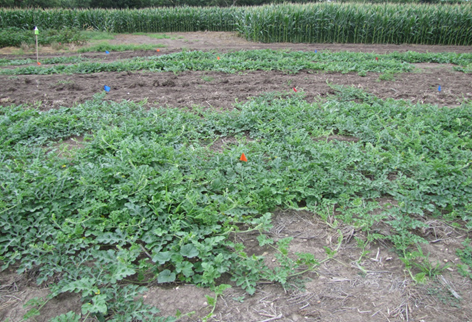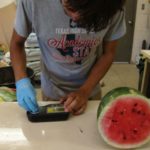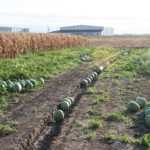Farm & Ranch
[AgriLife Today] Study investigates impact of strip tillage on a high-value crop

By: Paul Schattenberg
Also addresses biological activity in soil
Writer: Paul Schattenberg, 210-859-5752, [email protected]
Contacts: Dr. Daniel Leskovar, 830-278-9151, [email protected]
Dr. Xuejun Dong, 830-278-9151, [email protected]
UVALDE – A study done by researchers at the Texas A&M AgriLife Research and Extension Center in Uvalde may help producers in the Texas Winter Garden region and other areas decide whether conservation tillage methods might benefit them in the production of high-value crops.
Conducted by Dr. Daniel Leskovar, a Texas A&M AgriLife Research vegetable physiologist and center director, in collaboration with Drs. Yahia Othman and Xuejun Dong, the study also includes research results on how strip tillage affects soil biological activity.
Strip tillage is a conservation tillage practice involving minimum tillage to create a seedbed condition that disturbs only the portion of the soil to contain the seed row. The no-till area has crop residues and undisturbed soil to cover at least 30 percent of the topsoil surface.
The results showed strip tillage not only had a positive effect on watermelon quality and yield, it also had a positive effect on the soil’s biological activity, said Leskovar, the primary investigator for the study. He noted study results were also recently presented at the annual meeting of the Southern Region of the American Society for Horticultural Science in Mobile, Alabama.
“Research has been done on the use of conservation tillage for traditional crops, but there’s not much out there on using conservation tillage to produce high-value crops,” he said. “Despite the economic importance of watermelon in the U.S., which the U.S. Department of Agriculture’s National Agricultural Statistics Service estimates $483 million annually, no study we know of has assessed the influence of strip tillage on this crop.”
Leskovar said the experiment setup was designed as a circular split plot replicated four times with soil tillage and irrigation level as primary and secondary components. The portion of the study relating to the impact on watermelon was conducted from 2012-2014 using two tillage practices – strip and conventional – at three irrigation levels.
A center pivot system was used for irrigation at levels of 100 percent, 75 percent and 50 percent evapotranspiration. Evapotranspiration refers to the amount of water transferred from the land to the atmosphere by evaporation from soil and other surfaces, including plant leaves.
The study was conducted over three spring seasons on an established clay soil site at the center.
“We have been employing conservation and conventional tillage practices under the center pivot area from 2009 to the present, so the portion of the study relating to soil biological activity reflects six years of these tillage practices,” he said. “The crop history of the field we used for the study included corn as a cover crop in 2009, cotton in 2010 and corn again from 2011-2015.”
Plant morphology, physiology and yield were determined by measuring the photosynthesis rate, stomatal conductance and chlorophyll content index. Fruit firmness was determined using a digital force gauge, and fruit sugar content was measured using a digital refractometer.
Measurements were taken at flowering, fruit development and harvest stages. Vine length was also measured at the harvest stage.
Total marketable yield and fruit quality, based on firmness and sugar content, were determined during the harvest period, with soil chemical and microbial analyses conducted at the end of the experimental period.
“One of the most interesting results of the study was that marketable watermelon yield from strip till was higher than conventional till during all three years of the study,” Leskovar said. “Across the three years, the greatest difference in marketable yields between the strip and conventional tillage systems was in the fruit size from 5 to 8 kilograms or about 11 to 18 pounds, which was 50 percent of the total yield. In addition, the sugar content of the watermelon, which we measured using the Brix scale, increased significantly as a result of employing strip tillage.”
Leskovar said the increased yield and sugar content for marketable watermelon are factors that should appeal to producers interested in planting that crop and to consumers for the potential improvement in taste.
Dong, an AgriLife Research assistant professor and crop physiologist at the center, said because tillage practices are critical for sustaining soil quality necessary for successful crop growth and productivity, it is also important to assess soil chemical and biological properties in the study.
He also noted that using strip tillage in clay soil such as that found in the Winter Garden can also necessitate the occasional use of conventional tillage.
The study revealed strip tillage had positive results on both yield of marketable watermelons and sugar content. It also improved various aspects of soil biological composition, including bacteria, fungi and certain nematodes. (Texas A&M AgriLife Rersearch photo)
“The ecosystem of clay soil is complex and dynamic,” he said. “Limited tillage helps preserve the macropores of the soil to allow for water to penetrate and reach the plant roots, and to protect the soil biology. But the reduction of tillage disturbance alone cannot alleviate the compaction of clay soil, so it may be necessary to do conventional tillage every five years or so to loosen it and help preserve its biological ecosystem.”
The study showed tillage practices at the site had increased total bacteria in the soil by 49 percent, active bacteria by 27 percent, active and total fungi by 37 percent, nematodes by 275 percent and electrical conductivity by 14 percent as compared to conventional tillage.
“However, strip till also significantly increased the number of root-feeding nematodes, which are harmful to plant roots, but these may be related to the previous (corn) crop since it did not affect the watermelon plants,” said Othman, formerly a research associate at the center and now an assistant professor at the University of Jordan in Amman. “It also reduced phosphorus and nitrate content as compared to conventional till, a response that could either be due to higher uptake of these elements by the watermelon plants or due to leaching in the strip bands.”
Leskovar noted while long-term studies aimed at assessing soil quality and cumulative yield are required to further validate the study’s results, yield and sugar content responses were consistent across the three years of the study, and there was an abundance of soil microbial activity as a result of using strip tillage.
“Of course, there are pros and cons to using strip till and other means of conservation tillage,” he said. “But now we have some results applicable to watermelon, and this research may stimulate additional investigations into the use of strip till or other conservation tillage practices in the production of high-value crops.”
-30-
Find more stories, photos, videos and audio at http://today.agrilife.org
Farm & Ranch
Acorn Toxicity

By Barry Whitworth, DVM, MPH
With the prolonged drought, most pastures in Oklahoma end up in poor condition. With the lack of available forage, animals may go in search of alternative foods.
If oak trees are in the pastures, acorns may be a favorite meal for some livestock in the fall. This may result in oak poisoning.
Oak leaves, twigs, buds, and acorns may be toxic to some animals when consumed.
To read more, pick up a copy of the November edition of North Texas Farm & Ranch magazine, available digitally and in print. To subscribe by mail, call 940-872-5922.

Farm & Ranch
Silver Bluestems

By: Tony Dean
There are a handful of grasses on North Texas grazing lands ranchers need to know, not because they are highly desirable, but rather because they are not of much value. I call them “decom” plants, which is am acronym for “Don’t Ever Count On Me.” Silver bluestem is a “decom” grass.
Silver bluestem is a perennial which grows in all areas of Texas. It can survive in almost all soil types, and in full sun conditions or in semi shade. It grows up to three feet tall and is easily recognized with the presence of the white fuzzy seed head. Also, one of the identifying characteristics of Silver bluestem is a bend in the stems at each node, causing the plants to take on a rounded shape as they mature.
To read more, pick up a copy of the November edition of North Texas Farm & Ranch magazine, available digitally and in print. To subscribe by mail, call 940-872-5922.

Farm & Ranch
Meanwhile Back At The Ranch

By: Rayford Pullen
Fall is here which means winter is closing in on us and before we officially get into winter, we need to make sure our factories are either producing or will be producing in a few months.
We have been pregnancy testing our cows this fall and if they are not bred or nursing a calf, we are bidding them adios. With annual costs somewhere between $900.00 and $1,000.00 per cow, those cows not producing a live weaned calf are costing us quite a bit.
To read more, pick up a copy of the November edition of North Texas Farm & Ranch magazine, available digitally and in print. To subscribe by mail, call 940-872-5922.
-

 Country Lifestyles2 years ago
Country Lifestyles2 years agoScott & Stacey Schumacher: A Growth Mindset
-

 Country Lifestyles8 years ago
Country Lifestyles8 years agoStyle Your Profile – What your style cowboy hat says about you and new trends in 2017
-

 HOME8 years ago
HOME8 years agoGrazing North Texas – Wilman Lovegrass
-

 Equine1 year ago
Equine1 year agoThe Will to Win
-

 Country Lifestyles5 years ago
Country Lifestyles5 years agoAmber Crawford, Breakaway Roper
-

 Outdoor9 years ago
Outdoor9 years agoButtercup or Primrose?
-

 Country Lifestyles8 years ago
Country Lifestyles8 years agoJune 2016 Profile – The man behind the mic: Bob Tallman
-

 Country Lifestyles8 years ago
Country Lifestyles8 years agoDecember 2016 Profile, Rusty Riddle – The Riddle Way






